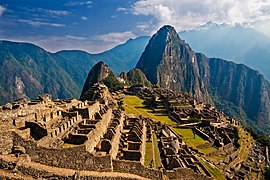Machu Pikchu | |
 Machu Picchu in 2007 | |
 Click on the map for a fullscreen view | |
| Alternative name | Machupicchu |
|---|---|
| Location | Urubamba, Cusco, Peru |
| Region | Cusco Department |
| Coordinates | 13°09′48″S 72°32′44″W / 13.16333°S 72.54556°W |
| Altitude | 2,430 m (7,972 ft) |
| Type | Settlement |
| History | |
| Founded | c. 1450 – c. 1470[1] |
| Abandoned | c. 1532 – c. 1565[2][3] |
| Cultures | Inca civilization |
| Site notes | |
| Discovered | Agustín Lizárraga (1902) Hiram Bingham (1911) |
| Condition | Preserved |
| Ownership | Peruvian Government |
| Management | Peruvian Ministry of Culture |
| Public access | Yes |
| Website | machupicchu.gob.pe |
| Official name | Historic Sanctuary of Machu Picchu |
| Location | Latin America and the Caribbean |
| Criteria | Mixed: i, iii, vii, ix |
| Reference | 274 |
| Inscription | 1983 (7th Session) |
| Area | 38,160.87 ha |
Machu Picchu[a] is a 15th-century Inca citadel located in the Eastern Cordillera of southern Peru on a mountain ridge at 2,430 meters (7,970 ft).[9] Often referred to as the "Lost City of the Incas",[10] it is the most familiar icon of the Inca Empire. It is located in the Machupicchu District within the Urubamba Province[11] above the Sacred Valley, which is 80 kilometers (50 mi) northwest of the city of Cusco. The Urubamba River flows past it, cutting through the Cordillera and creating a canyon with a subtropical mountain climate.[12]
The Inca civilization had no written language and following the first encounter by the Spanish soldier Baltasar Ocampo, no Europeans are recorded to have visited the site from the late 16th century until the 19th century. As far as historical knowledge extends, there are no existing written records detailing the site during its period of active use. The leading theory is that Machu Picchu was a private city for Incan royalty. The names of the buildings, their supposed uses, and their inhabitants, are the product of modern archaeologists based on physical evidence, including tombs at the site. Machu Picchu was built in the classical Inca style, with polished dry-stone walls. Its three primary structures are the Temple of the Sun, the Temple of the Three Windows, and the Intihuatana. From 1929 to 1971, Machu Picchu underwent extensive restoration and conservation work, including structural stabilization and artifact excavation, driven by government initiatives and research expeditions.[13] Most recent archaeologists believe that Machu Picchu was constructed as an estate for the Inca emperor Pachacuti (1438–1472). The Inca built the estate around 1450 but abandoned it a century later, at the time of the Spanish conquest. According to the new AMS radiocarbon dating, it was occupied from c. 1420–1532.[14] Historical research published in 2022 claims that the site was probably called Huayna Picchu by the Inca people themselves, as it exists on the smaller peak of the same name.[15][16]
Machu Picchu was declared a Peruvian Historic Sanctuary in 1982 and a UNESCO World Heritage Site in 1983.[9] In 2007, Machu Picchu was voted one of the New Seven Wonders of the World in a worldwide internet poll.[17]
- ^ Burger & Salazar 2004, p. 27.
- ^ Burger & Salazar 2004, p. 209.
- ^ Lumbreras 2020a, pp. 193–232.
- ^ "Machu Picchu". Lexico UK English Dictionary. Oxford University Press. Archived from the original on 28 January 2021.
- ^ a b "Machu Picchu". Merriam-Webster.com Dictionary. Merriam-Webster.
- ^ "How to say: Machu Picchu". BBC Blogs. BBC. 8 September 2006. Retrieved 12 August 2024.
- ^ "Machu Picchu se escribe con doble «c» en «Picchu»". FundéuRAE. August 2022. Retrieved 17 August 2024.
- ^ Nonato Rufino Chuquimamani Valer; Carmen Gladis Alosilla Morales; Victoria Choque Valer (2014). "Qullaw Qichwapa Simi Qullqan" (PDF) (in Quechua). Ministry of Education of Peru. p. 70. Archived from the original (PDF) on 29 November 2014. Retrieved 12 August 2024.
- ^ a b "Historic Sanctuary of Machu Picchu". UNESCO World Heritage Centre. UNESCO. Retrieved 12 August 2024.
- ^ Hearn, Kelly; Golomb, Jason (21 January 2017). "Machu Picchu". National Geographic. Retrieved 12 August 2024.
- ^ "Historic Sanctuary of Machupicchu". National Service of Natural Protected Areas by the State (SERNANP). 21 January 2022. Retrieved 12 August 2024.
- ^ Spizzichino, Daniele; Masini, Nicola; Lasaponara, Rosa; Margottini, Claudio (2022). "Machu Picchu Physiographic and Environmental Settings". In Ziółkowski, Mariusz; Masini, Nicola; Bastante, José M. (eds.). Machu Picchu in Context. Cham: Springer. pp. 3–20. doi:10.1007/978-3-030-92766-0_1. ISBN 978-3-030-92765-3.
- ^ Bastante et al. 2020a, pp. 167–170.
- ^ Burger, R. L.; Salazar, L. C.; Nesbitt, J.; Washburn, E.; Fehren-Schmitz, L. (August 2021). "New AMS dates for Machu Picchu: results and implications". Antiquity. 2021 (383): 1265–1279. doi:10.15184/aqy.2021.99. ISSN 0003-598X. S2CID 238220619.
- ^ Cite error: The named reference
:0was invoked but never defined (see the help page). - ^ Romo, Vanessa (27 March 2022). "We've been calling Machu Picchu by the wrong name". NPR. National Public Radio. Retrieved 12 August 2024.
- ^ "Creating Global Memory". New7Wonders of the World. Retrieved 25 October 2017.
Cite error: There are <ref group=lower-alpha> tags or {{efn}} templates on this page, but the references will not show without a {{reflist|group=lower-alpha}} template or {{notelist}} template (see the help page).

